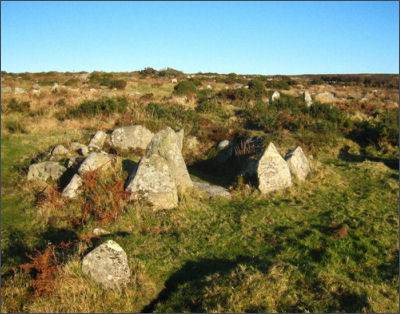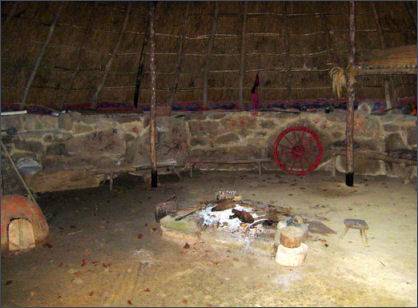Bodrifty Iron Age Village
OS grid ref:- SW 445354
 Bodrifty Iron Age village lies near Mulfra Hill in Cornwall's Penwith District, it is situated around 3 miles northwest of Penzance and 1.5 miles southwest of Porthmeor. It is also an area rich in monuments, with more than 16 quoits and tombs from the Neolithic period, and 20 stone monuments from the Bronze Age, seven being stone circles or holed stones.
Bodrifty Iron Age village lies near Mulfra Hill in Cornwall's Penwith District, it is situated around 3 miles northwest of Penzance and 1.5 miles southwest of Porthmeor. It is also an area rich in monuments, with more than 16 quoits and tombs from the Neolithic period, and 20 stone monuments from the Bronze Age, seven being stone circles or holed stones.
The Bodrifty village, regarded as one of the best-preserved of its kind in the world, has been estimated to date from the seventh century BC by Professor Tim Darvill, but James Dyer claims that Bodrifty began as an open settlement in the fourth century BC.
The site's significance is due in part to the wide range of pottery shards discovered there. Extensive excavations were carried out at Bodrifty in the early 1950s, most of the finds unearthed are now at the Royal Cornwall Museum in Truro. An analysis of the styles of pottery suggests that Bodrifty was inhabited from the fifth century BC to the first or second century AD.
The settlement consisted of eight structures surrounded by a stone wall which enclosed about three acres. The structures themselves had internal diameters of between three and eight metres. It is possible that the name means "the house by the summer shed" in the Cornish language.
Replica Roundhouse
In 1999, local smallholder Fred Mustill, who has a keen interest in archaeology, built a reconstruction of a roundhouse at Bodrifty Farm with the aid of a small grant. The task of building the replica required the shifting of granite rocks weighing several tons, felling, shaping and lashing hundreds of feet of timber, and hundreds of hours' work cutting reeds for the roof. Mustill had previously researched typical roundhouse architectural structure and surveyed other reconstructions in Cornwall. Traditional rab (granite sub soil) was used for the mortar and woods such as oak, ash, holly and hazel for the roof. The finished replica is an interpretation of the largest roundhouse at Bodrifty village, which is itself surprisingly well preserved after more than 2,000 years, with walls still 4 feet high in some places.


Mustill was keen for the house to be showcased as an educational aid for local children and others interested in history and archaeology, and hoped it would become a registered charity, though as of August 2011 it was being used for "luxury camping".
The Settlement, although on private land is open to the public. Off season the Roundhouse is available to visitors by appointment.
The copyright on the images on this page are owned by Rod Allday and licensed for reuse under the Creative Commons Attribution-ShareAlike 2.0 license.